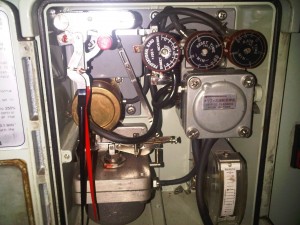Nakakita Temp controller repair/service
1: Nakakita Temper controller features
Nakakita Temper controller is designed by Japanese Nakakita Seisakusho Company based pneumatic .this simple but reliable and easy-operated instrument was used on most of vessels for M/E jacking high-temp cooling water,l.O temper as even as purifiers heater temp control.
The theory based a simple closed- loop circuit, the operator cell is a 3-way temper control valve, it changes the ratio of the heat-exchange flue to control the temper as controller required.
The controller main features as follows:
1) Air source pressure: 1.4bar
2) Control air pressure:0.2~1.0 bar
3) Controller character: P=proper band 10%~250%,I=reset time:20~0.1 minute,D=rate time:10~0.05min.
The operator (3-way valves) normally has two type: 1, butterfly valve, air source press: 4bar, control air pressure:0.2-1 bar.
2,plate valve: air source,1.5bar,control air press:0.2~1bar.
It depends to chose the 3 characters as P, PI, or PID.for example, the M/E jacket clg water temper is controlled by PID, when ship’s departure, the RPM will change large amplitude and high- speed rate, it will cause M/E jacket clg water changes rapid and big rate. So it must need t to add Rate Time to keep the temper normal as it best and prevent the damage from big stress of heat exchange. but for M/E l.O, PI control is enough.
PID CONTROLLER parameter setting
PICTURE ATTACHED
1: Setting Knob :
Turn the red knob to dial the setting value.
2: Proper band control dial, more little narrow the p, more sensitive controller is and the more accurate controller is, but if the P is too wide, it will cause oscillating, the controller can’t work stably.
If the P is too wider, the controller will react torpidly. The test value and setting value will be big clearance if even more torpidly, it will over control.
3, reset time dial, shorter the I, more quick to complete adjustment of the temp. but less stable for the controller. Vice versa, longer the reset time is, longer the adjustment time is.
4,rate time dial.this feature used in the system which has a longer delay. actually, it’s an advanced valve to balance the system delay. If the rate timer is too long, the system will get oscillating, if its too shorter, system can’t get a satisfactory effect.
PID adjustment as below via the case.
The proper adjustment as the following procedure :
Step 1, slow down “P ” band from 250% to 10%, check the result of temp control. when the testing dial gets disturbance, the controller gets stable after 2~4 waves, it proves the “P” band is proper.
Step 2, turn down the reset time slowly, when it reaches the critical value, the controller will get oscillating, then increase tiny and stay it.
Step 3, set the rate time as a quarter of reset time or the half of system delay time(it depends).in that case, the “P” band can be a little narrow.
Above is the regular procedure for most of Nakakita temp controller.
In a real case, the most probable problem that might happen to is the controller for M/E jacket clg water. the rate time occasionally affects the clearance of the system. As most chief’s experience, The P band can be set as 25%~30%. reset time set as 0.5~0.6 mins. and then observe the temperature of the water. if the controller dial moves little or even does not move when the water temp is rising up, that means the rate time effect is too weak. if the controller dial moved at a big range, the temper drop down so quickly, that means the rate time is beyond the normal.
Generally, the rate time should be set less than 5 mins. Think involved the system delay time and a three-way valve, we can set rate time as 1/2 as the delay time. Fyi, the delay time can’t be measured so accurately in real condition.so you have to test over times before you can set a proper rate time.
Here is the case I ever met on one bulk carrier. The M/E jacket cooling water got a high temperature when ship’s gonna departure, and the water reached the alarm point (90℃)in a very short time that will force the M/E slow down automatically. To avoid the rapid raising, the crew reduced the setting value when it’s going up to 86 degree and set back when the temperature got down. This maneuvering operates actually gave the system an advance time for adjustment. That’s what the rate time works.
So I adjusted the rate time from 0.3 mins to 0.4 mins. The temper changing obviously slow down. Also, I checked out the air supply was 1.5 bar not as the standard 1.4 bar, when it was changed back, the M/E jacket cooling water temper control was completely in order.

